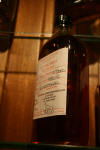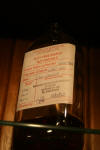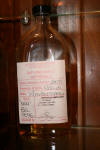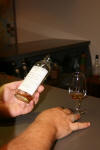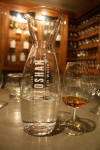The Toshan Man
Mark Dermul
Distillery Visit
24 September 2010
That particular Friday would change Mark's life forever. It was the day when he first visited the birthplace of his beloved whisky and got a behind-the-scenes tour by Head Distiller (and now personal friend) Jeremy Stephens.
Distillery Visit
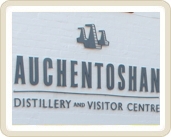 On
Friday 24th September 2010, Mark - together with his Dearly Beloved Sofie and
a befriended couple Niek & Ilse - visited the birthplace of his most
beloved whisky just off the Great Western Road in by Dalmuir, near
Glasgow.
On
Friday 24th September 2010, Mark - together with his Dearly Beloved Sofie and
a befriended couple Niek & Ilse - visited the birthplace of his most
beloved whisky just off the Great Western Road in by Dalmuir, near
Glasgow. Head Distiller Jeremy Stephens spent a whole afternoon and evening with him and his company to show him around the distillery and allow him to taste some cask samples. It will be a day long remembered. This is his report.
Flash Floods
Just two days before our visit, the Auchentoshan
distillery got hit by flash floods, so they were not in
production when we got there. All the machinery needed
to be dried, revised and re-installed. Production would
not resume for at least a week. But in the grand scheme
of things – say, about 12 years – that doesn’t really
interrupt things. And it didn’t stop Jeremy from taking
us
on a behind-the-scenes tour of the distillery. It
will be a day, long remembered.

Triple Distilled
Due to the flash floods, the mash tun had been completely emptied and
cleaned. In one of the four washbacks (which each can
hold 38.000 litres) fermentation was coming to an end.
It was filled with a lukewarm wash. Jeremy encouraged us
to taste it. ‘You first,’ I joked, as I had read
somewhere that drinking from the wash will keep you
securely locked up in a bathroom for the remainder of
the week. ‘Oh, no, not at all,’ Jeremy assured us. He
tasted it first, we followed suit. This beer-like liquid
reminded me of a slightly acid white beer.

Mash Tun

In the rather small still room we encountered the three stills side by
side – wash still, intermediate still and spirit still.
And that’s where Auchentoshan differs quite a bit from
its colleagues in Scotland. Auchentoshan is (bar a few
exceptions, such as Springbank for their Hazelburn) the
only Scottish distillery to triple distill. Jeremy
allowed us a sip of their new make spirit (with a
staggering ABV of 81%) and was happy to learn that we
found it to be Auchentoshan-style immediately.
Triple distillation is a lot more than simply moving the low wines from
the wash still to the intermediate still and then on to
the spirit still.
Jeremy explains: ‘At Auchentoshan, we maintain the tradition of triple
distillation, which delivers a lighter, more delicate
spirit. We charge the wash into the wash still, which
has a capacity of 17.500 liters, at 8% and add steam to
make the wash boil. The vapors rise to the top of the
still and go through the lyne arm. Behind the wall is a
condenser, a small copper tube surrounded by other tubes
that contain cold water. The hot vapors hit the tubes
and are turned back into liquid and are then – passing
through the spirit safe – collected in the low wines
receiver at an ABV of about 20%.
Contrary to most distilleries, our low wines are not pumped into the
spirit still, but are charged into the intermediate
still for a second distillation. Our intermediate still
has a capacity of 8.200 liters. We thus increase the
strength up to about 55%. We’ll then charge that into
the spirit still.

Because of the fact that we charge our spirit still at a higher strength,
our new make spirit will have an ABV of 81% as opposed
to the more common strength between 66% and 72% ABV. The
spirit still has a capacity of 11.500 liters. After
distillation in the spirit still, the spirit is
collected in the spirit receiver and ready to be put to
sleep in casks.
Triple distillation makes for more interaction with the copper and gives
us a cleaner, less sour and less sulphury, more delicate
and healthier spirit. We are able to put a cleaner, less
stale spirit into the cask for maturation. The character
of the cask is, I think, detectable earlier and gives a
faster maturation. Auchentoshan is a very accessible
whisky, truly a whisky for everyone!’
Bottle Your Own
In the dunnage warehouse, about 1,500 casks of whisky are currently
maturing, stacked three high. Most are bourbon barrels,
a smaller proportion are sherry hogsheads and finally
there about 60 Bordeaux wine casks. The warehouse is
dark and musty and – just like in a museum – you
suddenly turn very quiet without being told, a little in
awe of all that beauty.

Visitors to the distillery get the chance to bottle their own from a
specially selected cask. At the time of our visit, it
was a bourbon barrel from 1996, containing a wonderful
13 Year Old. All bottles in the ‘Bottle Your Own’
programme are logged. As luck would have it, I got
bottle no. 100 and Jeremy was happy to personalize and
sign the label for me.

The sun was already setting by the time we returned to the (already
closed) visitor centre to end our tour with a dram. But
we would get more than we bargained for...
The Blender's Room
In the stylish bar we were served the 21 Year Old - a magnificent whisky,
indeed. But Jeremy had a surprise for us in store. He
took us to the Blender’s Room and allowed us to sample
some fine whiskies that are not available to the public
(as they have not yet been bottled and thus are still
works in progress). We didn’t need to use a Jedi Mind
Trick to con him out of a sample of the 1978 Bourbon
Barrel Matured. Alas, he was able to grab the Auchentoshan 1957 50 Year Old out of my hands before I
could do any damage... ‘That’s £20!’ Jeremy joked when
he spotted me taking a whiff (not a sip!) from the
£2,600 bottle.


Cask Samples
We took our leave around 8.30 pm (!) in a way that outsiders would
consider to be the goodbye between old friends or
relatives. And that’s exactly how it felt. As a parting
gift, Jeremy handed us a sample bottle of new make
spirit. I am now, more than ever, a Toshan Man! Maybe it
was our imagination (or the excess of whisky we tasted),
but during our return to Glasgow, the moon gave our
sample bottles of moonshine a mysterious glow...




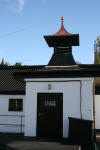

_small.jpg)






